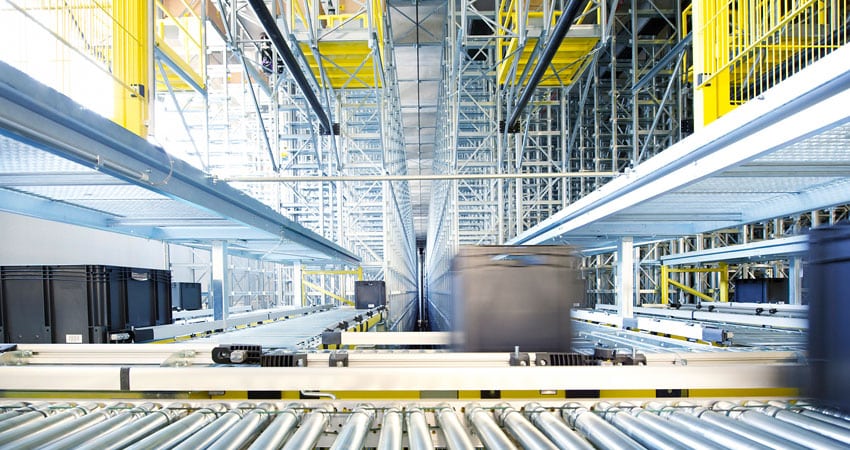Warehouse automation enables today’s retailers and brands to keep growing and preparing for the future, while being flexible and agile enough to adjust to sudden shifts in demand. There are many different flavors of advanced technology to help you get to where you need to be to remain competitive.
Technology on the Warehouse Floor
A wide array of warehouse automation options is available to optimize the fulfillment process, everything from pick-to-light to wearable devices to A-frames. To facilitate shipping, you can take advantage of things like automated boxing and dimensioning systems, label printers and applicators and automated parcel sortation.
Robotics, of course, is the biggest area of advancement. AI, optics and hardware have vastly improved in recent years. Autonomous mobile robots (AMRs), goods-to-person systems, automatic storage and retrieval systems (AS/RS) and robotic arms are just a few examples. These technologies can be used to increase productivity and reduce labor dependency in a variety of applications, including picking, replenishment and sortation.
One major advantage of today’s robotic systems is flexibility. Many are relatively quick to deploy. And you can essentially scale your fleet to suit your order volume, expanding to accommodate temporary fluctuations or long-term growth. You may need more sophisticated racking or takeaway conveying to support velocity, but this infrastructure can be added gradually. What’s more, much of the technology is relocatable, so if you outgrow your space, you can simply move the robots to a larger facility.
Robotic technologies have also become more economical. The entry-level investment is relatively low, even compared to five years ago, so they can deliver a comparatively quick ROI, particularly in the current tight labor market.
Options for rentals, Robotics-as-a- Service (RaaS) and outsourcing are making robots accessible for operations of all sizes. Options like these may be your best chance for getting your hands on one. Demand far exceeds supply, and supply chain limitations have hampered efforts to ramp up production capabilities.
Finding the Right Fit
When adding warehouse automation or robotics, start by laying the proper groundwork: defining current and future needs based on your order profile, and investing in the right systems (WMS, OMS, WES) to support them.
Anticipate factors that may increase your need for operational flexibility: growth forecasts, potential spikes in order volume due to promotions or peak selling periods, expansion into new markets or sales channels, etc. Then, research your options.
While the optimal automation or robotics solution design will be different for every fulfillment operation, one general rule applies across the board. Start with the simplest solution that can meet your needs and layer in technology that allows you to scale and flex quickly.
The possible applications are endless. Here are just a few scenarios:
- Do you need to process orders faster to meet SLAs? Print and apply shipping labels during the pick process using mobile printing technology.
- Is your product heavy or cumbersome? Equip associates with voice picking headsets for faster, hands-free picking.
- Do you anticipate a high volume of holiday orders? Make plans to rent AMRs for peak season.
- Is your warehouse bursting at the seams year-round? Install a goods-to-person solution to maximize storage density.
- Have thousands of outbound packages? Utilize a mechanized sorting system to automatically sort by carrier and level of service.
Dependence on Good Data
As operations grow in size and complexity, the effectiveness of technology solutions – and fulfillment solutions in general – depends on the availability of accurate data. This is an important point to keep in mind.
Size and dimensional weight of packages (DIM) in your order profile are key data points that guide many operational decisions. When these measurements are wrong, it can impede the ability to use automation and robotics. For example, if the product size is unknown or incorrect, a robot cannot function properly. Among other problems, missing or incorrect data can cause processing delays, impact storage and increase shipping costs.
Make sure that you have the ability to capture quality data and interpret it effectively. Inline scales and dimensioning equipment can help to capture these measurements at the point of pick or pack-out. Accurate data can then be input into your OMS, WMS and/or TMS and shared with your carriers.
Looking Ahead
No one has a cloudless crystal ball, but one thing is certain: the need for advanced technology is inevitable. If you want to provide a positive customer experience and stay ahead of your competition, start planning now for warehouse automation that can keep your business on track in a rapidly changing industry.
Note: This is the second installment of a two-part series. You can read part one here.
Brian Mattingly is vice president of operations for Saddle Creek Logistics Services

